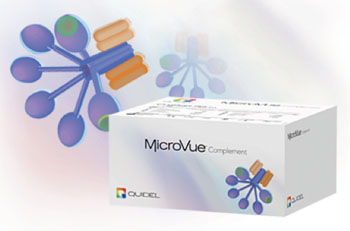Biomarker Outperforms Current Gold Standard to Detect Brain Shunt Infections
By LabMedica International staff writers
Posted on 15 Sep 2016
Children treated with cerebrospinal fluid (CSF) shunts to manage hydrocephalus frequently develop shunt failure and/or infections, conditions that present with overlapping symptoms.Posted on 15 Sep 2016
The potential life-threatening nature of shunt infections requires rapid diagnosis; however, traditional microbiology is time consuming, expensive, and potentially unreliable. A quick and accurate test for bacterial infection in brain shunts or meningitis would improve the quality and efficiency of patient care and patient outcomes. Such a test would also lower health care expenses by avoiding needless hospitalization and treatment.

Image: The MicroVue complement sC5b-9 Plus enzyme immunoassay kit (Photo courtesy of Quidel Corporation).
Scientists at the University of Alabama (Birmingham, AL, USA) prospectively enrolled 198 consecutive undergoing evaluation and treatment for newly diagnosed hydrocephalus, shunt infection, and versus malfunction. Study samples were collected at the same time as routine lab specimens to provide corresponding laboratory results for each specimen (glucose, protein, hematology indices, gram stain, and culture). Samples were labeled and stored at –20 °C and/or –80 °C for a period of one week on average prior to analysis.
Cerebrospinal fluid (CSF) CSF was assayed for the soluble membrane attack complex (sMAC) by enzyme-linked immunosorbent assay (ELISA) in patients with suspected shunt failure or infection. CSF was obtained at the time of initial surgical intervention. Statistical analysis was performed to assess the diagnostic potential of sMAC in pyogenic-infected versus non-infected patients. Soluble MAC was quantitated using the MicroVue complement sC5b-9 Plus enzyme immunoassay (Quidel Corporation, Athens, OH, USA). The lower limit of detection for the assay was 3.7 ng/mL.
The team used appropriately adjusted cutoff values for maximum sensitivity and specificity, and the sMAC was able to detect 14 of 15 infections in the 248 patients, while the current diagnostic gold standard of bacterial culture was less accurate, detecting only 11 of the 15 infections. At the best cutoff value, the test had excellent diagnostic capability with a sensitivity of 93% and a specificity of 86%. Children with pyogenic shunt infection had significantly increased sMAC levels compared with non-infected patients (3,211 ± 1,111 ng/mL versus 26 ± 3.8 ng/mL).
In infected patients undergoing serial CSF draws, sMAC levels were prognostic for both positive and negative clinical outcomes. Children with delayed, broth-only growth of commensal organisms such as Propionibacterium acnes, Staphylococcus epidermidis had the lowest sMAC levels (7.96 ± 1.7 ng/mL), suggesting contamination rather than shunt infection. The study was first published online on July 7, 2016, in the Journal of Clinical Investigation Insight.
Related Links:
University of Alabama
Quidel














